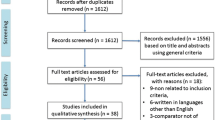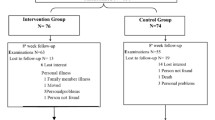Abstract
Background
Patients with chronic kidney disease (CKD) have impaired performance in physical tasks, lower health-related quality of life and high cardiovascular morbidity and mortality. Moderate intensity exercise has been shown to provide cardiovascular and metabolic benefits in healthy individuals and patients without CKD. Long-term exercise training is recommended as a vital component in the management of a number of chronic diseases. This randomized controlled pilot project examined the effects of exercise in predialysis CKD patients.
Methods
Ten patients were randomized to 12 months of exercise (EX) and 10 to standard care (CT). We compared the difference between the two groups in physical impairment (VO2peak and endurance time [ET]), arterial stiffness (augmentation index [AI]) and health-related quality of life (EuroQol EQ-5D and Short Form-36 questionnaires) (all measured at baseline and 12 months).
Results
The difference between EX and CT was statistically significant for VO2peak (3.59 ml O2/kg/min; 95% CI 0.92, 6.26; P = 0.01), ET (10.97 min; 95% CI 4.34, 17.59; P = 0.003) and AI (−11.7%; 95% CI −18.79, −4.61; P = 0.003). Clinically important changes were noted in EQ-5D and SF-36.
Conclusions
This study suggests that long-term exercise training improves physical impairment, arterial stiffness and health-related quality of life in patients with predialysis CKD. A larger randomized trial is required to examine the impact of exercise on markers of cardiovascular risk and quality of life in predialysis CKD patients.
Similar content being viewed by others
References
Levin A, Hemmelgarn B, Culleton B et al (2008) Guidelines for the management of chronic kidney disease. Can Med Assoc J 179:1154–1162
Johansen KL, Chertow GM, Ng AV et al (2000) Physical activity levels in patients on hemodialysis and healthy sedentary controls. Kidney Int 57:2564–2570
Padilla J, Krasnoff J, DaSilva M et al (2008) Physical functioning in patients with chronic kidney disease. J Nephrol 21:550–559
Blair SN, Kohl HW, Paffenbarger RS, Clark DG, Cooper KH, Gibbons LW (1989) Physical fitness and all-cause mortality: a prospective study of healthy men and women. JAMA 262:2395–2401
Myers J, Prakash M, Froelicher V, Do D, Partington S, Atwood JE (2002) Exercise capacity and mortality among men referred for exercise testing. N Engl J Med 346:793–801
Green DJ, O’Driscoll G, Joyner MJ, Cable NT (2008) Exercise and cardiovascular risk reduction: time to update the rationale for exercise? J Appl Physiol 105:766–768
O’Hare AM, Tawney K, Bacchetti P, Johansen KL (2003) Decreased survival among sedentary patients undergoing dialysis: results from the dialysis morbidity and mortality study wave 2. Am J Kidney Dis 41:447–454
Culleton BF, Hemmelgarn BR (2003) Is chronic kidney disease a cardiovascular disease risk factor? Semin Dial 16:95–100
Keith DS, Nichols GA, Guillion CM, Brown JB, Smith DH (2004) Longitudinal follow-up and outcomes among a population with chronic kidney disease in a large managed care organization. Arch Intern Med 164:659–663
Group Diabetes Prevention Program Research (2002) Reduction in the incidence of type 2 diabetes with lifestyle intervention or metformin. N Engl J Med 346:393–403
McGavock JM, Eves ND, Mandic S, Glenn NM, Quinney HA, Haykowsky MJ (2004) The role of exercise in the treatment of cardiovascular disease associated with type 2 diabetes mellitus. Sports Med 34:27–48
Sigal RJ, Kenny GP, Boule NG et al (2007) Effects of aerobic training, resistance training, or both on glycemic control in type 2 diabetes: a randomized trial. Ann Intern Med 147:357–369
Taylor RS, Brown A, Ebrahim S et al (2004) Exercise-based rehabilitation for patients with coronary heart disease: systematic review and meta-analysis of randomized controlled trials. Am J Med 116:682–692
Smart N, Marwick TH (2004) Exercise training for patients with heart failure: a systematic review of factors that improve mortality and morbidity. Am J Med 116:693–706
Ries AL, Bauldoff GS, Carlin BW et al (2007) Pulmonary rehabilitation: joint ACCP/AACVPR evidence-based clinical practice guidelines. Chest 131:4S–42S
Koufaki P, Mercer TH, Naish PF (2002) Effects of exercise training on aerobic and functional capacity of end-stage renal disease patients. Clin Physiol Funct Imaging 22:115–124
Johansen KL (2008) Exercise and dialysis. Hemodial Int 12:290–300
Painter P (2005) Physical functioning in end-stage renal disease patients: update 2005. Hemodial Int 9:218–235
Thompson PD, Buchner D, Pina IL et al (2003) Exercise and physical activity in the prevention and treatment of atherosclerotic cardiovascular disease. Circulation 107:3109–3116
Petrella R, Lattanzio CN, Demeray A, Varallo V, Blore R (2005) Can adoption of regular exercise later in life prevent metabolic risk for cardiovascular disease? Diabetes Care 28:694–701
Booth FW, Gordon SE, Carlson CJ, Hamilton MT (2000) Waging war on modern chronic diseases: primary prevention through exercise biology. J Appl Physiol 88:774–787
Dickinson HO, Mason JM, Nicolson DJ et al (2006) Lifestyle interventions to reduce raised blood pressure: a systematic review of randomized controlled trials. J Hypertens 24:215–233
Stewart KJ (2002) Exercise training and the cardiovascular consequences of type 2 diabetes and hypertension: plausible mechanisms for improving cardiovascular health. JAMA 288:1622–1631
Durstine JL, Grandjean PW, Davis PG, Ferguson MA, Alderson NL, DuBose KD (2001) Blood lipid and lipoprotein adaptations to exercise: a quantitative analysis. Sports Med 31:1033–1062
Hardman AE (1999) Interaction of physical activity and diet: implications for lipoprotein metabolism. Public Health Nutr 2:369–376
Sato Y, Nagasaki M, Nakai N, Fushimi T (2003) Physical exercise improves glucose metabolism in lifestyle-related diseases. Exp Biol Med (Maywood) 228:1208–1212
Houmard JA, Tanner CJ, Slentz CA, Duscha BD, McCartney JS, Kraus WE (2004) Effect of the volume and intensity of exercise training on insulin sensitivity. J Appl Physiol 96:101–106
Vaitkevicius PV, Fleg JL, Engel JH et al (1993) Effects of age and aerobic capacity on arterial stiffness in healthy adults. Circulation 88:1456–1462
Mustata S, Chan C, Lai V, Miller JA (2004) Impact of an exercise program on arterial stiffness and insulin resistance in hemodialysis patients. J Am Soc Nephrol 15:2713–2718
Briet M, Bozec E, Laurent S et al (2006) Arterial stiffness and enlargement in mild-to-moderate chronic kidney disease. Kidney Int 69:350–357
Blacher J, Guerin AP, Pannier B, Marchais SJ, Safar ME, London GM (1999) Impact of aortic stiffness on survival in end-stage renal disease. Circulation 99:2434–2439
London GM, Blacher J, Pannier B, Guerin AP, Marchais SJ, Safar ME (2001) Arterial wave reflections and survival in end-stage renal failure. Hypertension 38:434–438
National Kidney Foundation (2005) K/DOQI Clinical practice guidelines for cardiovascular disease in dialysis patients. Am J Kidney Dis 45(Suppl 3):S1–S153
Borg GA (1982) Psychophysical bases of perceived exertion. Med Sci Sports Exerc 14:377–381
Chen CH, Nevo E, Fetics B et al (1997) Estimation of central aortic pressure waveform by mathematical transformation of radial tonometry pressure. Validation of generalized transfer function. Circulation 95:1827–1836
Canadian Agency for Drugs and Technologies in Health (2006) Guidelines for the economic evaluation of health technologies: Canada, 3rd edn. Ottawa
Manns B, Johnson JA, Taub K, Mortis G, Ghali WA, Donaldson C (2003) Quality of life in patients treated with hemodialysis or peritoneal dialysis: what are the important determinants? Clin Nephrol 60:341–351
Wight JP, Edwards L, Brazier J, Walters S, Payne JN, Brown CB (1998) The SF36 as an outcome measure of services for end stage renal failure. Qual Health Care 7:209–221
Dolan P (1997) Modeling valuations for EuroQol health states. Med Care 35:1095–1108
Liem YS, Bosch JL, Hunink MG (2008) Preference-based quality of life of patients on renal replacement therapy: a systematic review and meta-analysis. Value Health 11:733–741
Boyce ML, Robergs RA, Avasthi PS et al (1997) Exercise training by individuals with predialysis renal failure: cardiorespiratory endurance, hypertension, and renal function. Am J Kidney Dis 30:180–192
Sietsema KE, Amato A, Adler SG, Brass EP (2004) Exercise capacity as a predictor of survival among ambulatory patients with end-stage renal disease. Kidney Int 65:712–724
Cheema BS, Fiatarone Singh MA (2005) Exercise training in patients receiving maintenance hemodialysis: a systematic review of clinical trials. Am J Nephr 25:352–364
Kodama S, Saito K, Tanaka S et al (2009) Cardiorespiratory fitness as a quantitative predictor of all-cause mortality and cardiovascular events in healthy men and women: a meta-analysis. JAMA 301:2024–2035
Covic A, Gusbeth-Tatomir P, Goldsmith D (2005) Arterial stiffness in renal patients: an update. Am J Kidney Dis 45:965–977
Hoeymans N, van Lindert H, Westert GP (2005) The health status of the Dutch population as assessed by EQ-6D. Qual Life Res 14:655–663
Painter P, Carlson L, Carey S, Paul SM, Myll J (2000) Physical functioning and health related quality of life changes with exercise training in hemodialysis patients. Am J Kidney Dis 35:482–492
Painter P, Carlson L, Carey S, Paul SM, Myll J (2000) Low-functioning hemodialysis patients improve with exercise training. Am J Kidney Dis 36:600–608
Haskell W, Lee I, Pate R et al (2007) Physical activity and public health: updated recommendations for adults from the American College of Sports Medicine and the American Heart Association. Circulation 116:1081–1093
Nelson M, Rejeski WJ, Blair S et al (2007) Physical activity and public health in older adults: recommendation from the American College of Sports Medicine and the American Heart Association. Circulation 116:1094–1105
Nonoyama ML, Brooks D, Ponikvar A et al. (2010) Exercise program to enhance physical performance and quality of life of older hemodialysis patients: a feasibility study. Int Urol Nephrol Mar 7 [Epub ahead of print]
Segura-Orti E, Kouidi E, Lison JF (2009) Effect of resistance exercise during hemodialysis on physical function and quality of life: randomized controlled trial. Clinic Nephrol 71:527–537
Sakkas GK, Hadjigeorgiou GM, Karatzaferi C et al (2008) Intradialytic aerobic exercise training ameliorates symptoms of restless legs syndrome and improves functional capacity in patients on hemodialysis: a pilot study. ASAIO J 54:185–190
Author information
Authors and Affiliations
Corresponding author
Appendix
Rights and permissions
About this article
Cite this article
Mustata, S., Groeneveld, S., Davidson, W. et al. Effects of exercise training on physical impairment, arterial stiffness and health-related quality of life in patients with chronic kidney disease: a pilot study. Int Urol Nephrol 43, 1133–1141 (2011). https://doi.org/10.1007/s11255-010-9823-7
Received:
Accepted:
Published:
Issue Date:
DOI: https://doi.org/10.1007/s11255-010-9823-7




